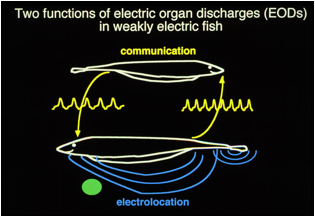Learn About Electric Fish
Functions of electric organ discharges (EODs)
Predator defense/stunning prey
A few species of electric fish (i.e., strongly electric catfishes, Torpedo rays, and electric eels) produce extremely strong electric discharges (hundreds of volts) from their electric organs. Such strong discharges can repel predators and/or stun prey.

Electrolocation
Most species of electric fish produce electric discharges that are far too weak to stun prey or predators (millivolts/cm). One function of weak electric organ discharges is electrolocation. The discharges emitted from the electric organ create a weak, oscillating electric field around the fish. This electric field is distorted by objects that differ from the water in electrical resistance or capacitance. Electroreceptors in the fish's skin allow it to detect these distortions in the electric field and thereby obtain information about nearby objects or organisms. Electrolocation is particularly useful for weakly electric fish because many species are nocturnal and/or live in turbid water.
Communication
In addition to being able to detect their own discharges, electric fish can also detect the discharges of other fish. The discharges of fish of different species, different sexes, and even different individual fish, are often distinctive. Thus, weakly electric fish are also able to use their EODs to communicate information about their species identity, sex, and reproductive status.
